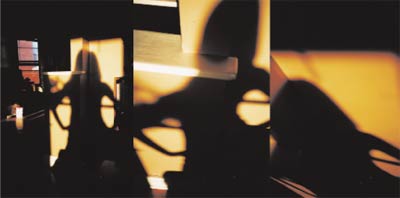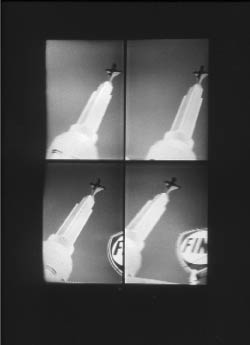The Lomographic Society – Where Dada Meets the Snapshot

What is the Lomographic Society? According to Matthias Fiegl, he and Wolfgang Stranzinger started making snapshots with the Russian made Lomo Kompakt Automat camera during their student days in Vienna. People began asking them where they could get this tank-like camera and soon they were smuggling the cameras into Vienna. This led them to form the “Lomographic Society” and arrange the first Lomographic exhibition with 50 of their friends in November 1992.
Their basic concept was to treat everybody’s pictures equally, which lead to the creation of a “Lomo Wall” on which the small machine-made prints were arranged side by side. In 1994 they held their first international exhibition in Moscow and New York (10,000 pictures of each city in the other city). Since then, they have organized around 500 exhibitions and events around the world, opened 70 “Lomographic Embassies” where the “Lomographic ambassadors” organize events, exhibitions, and promote an expanded line of unusual cameras.
Recently, the US Lomo ambassador sent me some of their “toy” cameras with their far from perfect plastic lenses, mechanics, and viewfinders to test. I started with the Super Sampler that makes four horizontal or vertical sequential slice-like exposures on a 35mm frame. The sequential drive is powered by a hand-pulled ripcord on a thin piece of string and can be set to either high-speed (4 exposures in 0.2 seconds) or standard (4 exposures in 2 seconds) speed.

Next there is the Action Sampler that makes four rectangular sequential exposures on a single 35mm frame. I didn’t test this camera as I had previously photographed with an earlier version of this format called an Action Tracker, which aside from cosmetics appear extremely similar. I decided to concentrate on the Pop 9, which makes nine simultaneous exposures on a 35mm frame, after reading the slick graphic instructional manual written with such hyperbole and irony that it caused me to laugh aloud:
“Run your fingers along your Pop 9 and examine it closely. This glimmering 9-lens gem is locked and loaded to catapult your consciousness into here-to-fore-unknown realms of pop expression and sheer, crushing ecstasy…”
It is the most humorous camera manual I have ever read and typical of how the Lomo Society positions itself as the provider of fun, sexy, good-times cameras. The premium price for all the cameras includes membership in the Lomographic Society, featuring the “10 Golden Rules” that blends Dadaist philosophy with the snapshot by urging one to – Take your camera everywhere, shoot from the hip, get close, don’t think, be fast, don’t have to know beforehand what you captured on film, and not worry about any rules.
With that spirit in mind, I used the Pop 9 to make snapshots at art openings, performances, parties, and of pets. People were curious about this strange 9-lens camera and willing to let me take their picture. I got my best results when I was within 6 feet of my subject and used its mini built-in flash. The nine lenses are not perfectly aligned so you get nine slightly different views of each subject.

I gave their top of the line Russian Lomo Kompakt Automat to photographer, Molly Jarboe, who took it on a trip to Kansas City. The Lomo comes with a 32mm f/2.8 glass lens and offers a choice of aperture priority exposure or automatic exposure mode, zone focusing, but no built-in flash. Jarboe observed that one can get a camera with similar features for considerably less money, but the Lomo’s unconventional looks generate an aura of curious attention that encourages her subjects to grant her the authority to do “endless in-your-face snapping.”
Jarboe reflects, “The Lomo begs a visual investigation of the quotidian flow of daily life. The capricious from-the-hip shooting, with no expectations about the results, is a vacation from the Pentax 6×7 I once lugged around and provides an existential leap from the highly composed themes I approach with my Hasselblad.”
To learn more about this self-proclaimed art movement I asked founder Matthias Fiegl about the Lomographic Society.
Robert Hirsch: How is Lomo-graphic Society different from the point-and-shoot phenomena?
Matthias Fiegl: Point-and-shoot is a technical term, people just want to get their family and holiday pictures easier, and the industry offers point-and-shoot cameras, to make the same photographic expression even easier to achieve. When the people become member of the society and buy a camera, they get content delivered with the camera: the ideas, the philosophy, lots of pictures, which starts people thinking and encourages their desire to make different, artistic pictures.
RH: Are you aware of the art and photography movements that relate to the Lomo?
MF: Sure. They include: Russian folk painting, Russian film and photography from the beginning of the twentieth century, Dada, Pop Art, Warhol’s Factory, Joseph Beuys, and the Holga camera.
RH: Do you design any of the cameras you sell?
MF: We do most of the design. We change the camera surface and colors (Action Sampler, Pop 9). We create our own camera ideas, patents and designs (Supersampler and more under development at the moment). We create the packaging for the cameras and we design content within our events, competitions and exhibitions —call it the marketing for the cameras.
RH: How would you describe the language used to market your cameras?
MF: Emotional, funny, enthusiastic, getting the people to run and shoot and “do-it-yourself”, sometimes a little bit old school, just for fun, like creating this Lomographic world with embassies, world congresses and archives.
RH: How do you become a member and what are the benefits?
MF: When you buy a camera, you automatically become a member. When you leave us your address, at the place you buy the camera or online registration, you get information by e-mail and mail about all the events, competitions and new products. We are currently working on a more detailed membership system.
RH: Who is the typical Lomo user?
MF: They are educated people, students, photographers, graphic designers, artists, doctors, lawyers, and journalists, between 20 to 40 years old. They tend to be active people who enjoy going out, meeting friends, traveling, art, listening to music, and reading books. We estimate there are now about 500,000 Lomographers worldwide who communicate and collaborate within a network of 70 Lomo-graphic Embassies and internet.
RH: What happens at a typical Lomo gathering?
MF: Usually, we have an exhibition going on and some interactive projects, like lend a Lomo and shoot something according to a theme. There are many open-minded people who enjoy a speedy night meeting new people. Their main drink is Vodka and their main camera is the Lomo LCA! People take a lot of pictures at a Lomo gathering!
RH: What is a Lomo wall?
MF: They are made up of thousands of small pictures, one beside each other, from hundreds of different Lomographers. They rock along the wall in a certain rhythm—very intense, very colorful, abstract from far away, rich in content when you get closer! [Lomo sells plastic “Fotoclips” with companion 3-D plug-in clips that allows small photographs to easily be attached to each other so that one may build anything from a wall to a sculpture].
RH: What’s next?
MF: We held the biggest Lomo-graphic event ever: the 10th Anniver-sary Lomographic World Congress in Vienna during November 2002. We introduced two new analog cameras and a digital camera along with other new products including shirts and underwear (“only naked is better”), new website features including a Archive, new Lomographic retail shops in Tokyo, Hong Kong, and New York, plus lots of events and worldwide competitions.
We also have the first official book on Lomography, “Don’t Think—Just Shoot,” compiled by Lomography London Ambassador Fabian Monheim that is jam-backed with images of people and animals, facts, figures, and anecdotes. It is published by Booth-Clibborn Editions (www.booth-clib born.com).
RH: Anything else the Photovision readers should know about the Lomo?
MF: Lomography is a strong tool to get a creative insight in your own life. Enjoy the little instrument in your hand, telling you stories about life, getting you in contact with other people, make people laugh and enjoy and finally—create art and beauty!
What I have observed is that when people purchase a Lomo product they are also buying into a worldwide, non-restrictive club devoted to a non-critical way of making photographs that record daily life. This impulse can be traced directly back to the advent of the hand-held camera and the snapshot in which traditional aesthetic criteria of content, form and technique were tossed out the window. The attitude of the snapshooters was direct, spontaneous, and matter-of-fact. Their concerns were personal and their approach was unpretentious. Looking through the Lomo book or website reveals the classic amateur “mistakes” usual angles, unbalanced compositions, extremes in lighting that helped to transform pictorial conventions and influence modern art movements from surrealism to professional photography.
Even though the Lomographic Society does not advocate a particular ideology, photographers can sort and study their prints after making them in order to discover visual and intellectual trends in their work that they can pursue in the future.
After ten years has the Lomo concept run its course or will it find new life by expanding its product line and creating a virtual online club? The Lomo cameras are pricey and their latest products takes them further away from their original impulse, but in an era of Enron-style corporate corruption there is something refreshingly straight forward about people turning a profit by playfully promoting the making and displaying of photographs.
For additional information visit: www.lomography.com. Freestyle Photographic Supplies (www.freestylephoto.biz) also carries the Lomo line.
![]()
